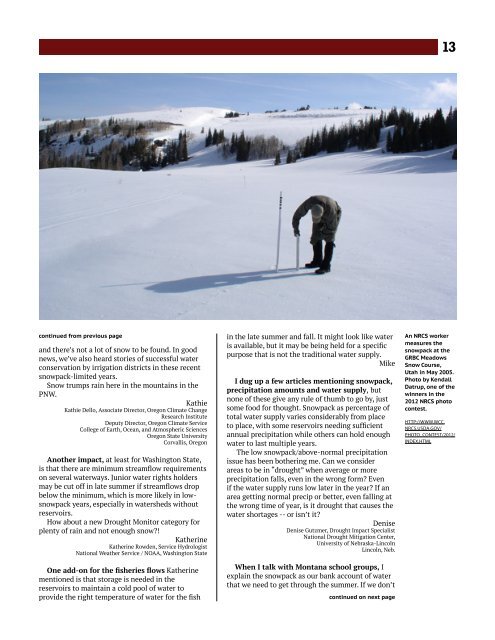12DATA AND TOOLSA conversation about snowpack and its significance to drought in the West‘Our biggest and mostimportant reservoir’Each week the author of the U.S. Drought Monitor map siftsthrough input from as many as 350 observers and contributors aroundthe nation. The exchange of information from sources reporting onprecipitation, soil moisture, stream flows and other factors, lays thefoundation for the depiction of drought that week.Snowpack is an element that goes into assessing and predictingdrought, especially in the West. But what happens when it rains a lotinstead of snowing? Can there be a “snow drought?”A Drought Monitor author posed this question to the group inFebruary, when much of what had typically fallen as snow in the winterwas now taking liquid form.Read on to follow the conversation and learn more abuot the role ofsnowpack and the nature of drought.BY THE USDMCOMMUNITYMultiple AgenciesWe had an interesting discussion during ourU.S. weather briefing today at USDA, and it raiseda question that I know there’s no easy answer for,but whatever guidance we could get would be a bighelp.In many areas of the West, in particularthe Northwest, we see near- to above-normalrainfall but at the same time much below-normalsnowpack. If you have a mild, wet winter (evenwetter than normal), and you enter the spring withfull reservoirs but meager snowpack, what role willthe meager snowpack play moving forward?More simply put, what percentage of total wateruse does the snowpack supply? I expect the answeris complex…EricEric D. Luebehusen, Meteorologist, USDAOffice of the Chief Economist, World Agricultural Outlook BoardWashington, D.C.Good question. The main challenge lies in thetype and use of the reservoirs we have in the West.For reservoirs with no flood control capacity, itdoesn’t matter as much as for those which rely onsnowmelt to fill the flood reserve space that is heldthrough the winter.The exception to that rule is for reservoirs thatmodulate the flow distribution of the snowmeltto accommodate water use through the summer.These reservoirs are usually small compared tothe runoff volume of the watershed behind them.Mother Nature doesn’t always provide a nicesmooth distribution of snowmelt runoff throughthe spring and summer. In those cases the reservoiris managed more heavily to try to balance runoffand deliveries without “losing” too much runoff toflows over the spillway.Each watershed is unique in its structure,and water management needs and input fromthe community are vital. For reservoirs thathave a flood reserve space, the snowpack is likea secondary reservoir that is used to fill in thatspace through the spring and then can be used fordeliveries through the summer and fall for a varietyof purposes.When the snowpack isn’t there, there is a lot lesswater to work with to balance a bunch of competingneeds. If there are a lot of winter flows, any waterthat goes into the flood reserve space in thereservoir must be released as soon as it is safe to doso, and is often “lost” for other purposes.There’s a lot of research on how to use forecaststo enable more dynamic consideration of how muchflood reserve space to have on hand in reservoiroperations.MikeMichael Anderson, State ClimatologistCalifornia Department of Water ResourcesSacramento, Calif.I echo what Mike said regarding reservoirs.There are many papers on the importance ofthe snowpack to the Pacific Northwest (PNW);the Northwest chapter of the National ClimateAssessment covers this in detail. Not all of oursurface water supply is fed by a man-madereservoir. We rely on the snow to act as our biggestand most important reservoir.Beyond hydrology, there are the factors of soilmoisture and bare ground, which can exacerbatewildfires in the summer (though in-seasonconditions matter a lot as well), and impact a multimilliondollar winter recreation industry.We haven’t had much of a winter here and it isvery apparent. Bend’s annual WinterFest is thisweekend (Feb. 14, <strong>2015</strong>); it will be in the high 50scontinued on next page
13continued from previous pageand there’s not a lot of snow to be found. In goodnews, we’ve also heard stories of successful waterconservation by irrigation districts in these recentsnowpack-limited years.Snow trumps rain here in the mountains in thePNW.KathieKathie Dello, Associate Director, Oregon Climate ChangeResearch InstituteDeputy Director, Oregon Climate ServiceCollege of Earth, Ocean, and Atmospheric SciencesOregon State UniversityCorvallis, OregonAnother impact, at least for Washington State,is that there are minimum streamflow requirementson several waterways. Junior water rights holdersmay be cut off in late summer if streamflows dropbelow the minimum, which is more likely in lowsnowpackyears, especially in watersheds withoutreservoirs.How about a new Drought Monitor category forplenty of rain and not enough snow?!KatherineKatherine Rowden, Service HydrologistNational Weather Service / NOAA, Washington StateOne add-on for the fisheries flows Katherinementioned is that storage is needed in thereservoirs to maintain a cold pool of water toprovide the right temperature of water for the fishin the late summer and fall. It might look like wateris available, but it may be being held for a specificpurpose that is not the traditional water supply.MikeI dug up a few articles mentioning snowpack,precipitation amounts and water supply, butnone of these give any rule of thumb to go by, justsome food for thought. Snowpack as percentage oftotal water supply varies considerably from placeto place, with some reservoirs needing sufficientannual precipitation while others can hold enoughwater to last multiple years.The low snowpack/above-normal precipitationissue has been bothering me. Can we considerareas to be in “drought” when average or moreprecipitation falls, even in the wrong form? Evenif the water supply runs low later in the year? If anarea getting normal precip or better, even falling atthe wrong time of year, is it drought that causes thewater shortages -- or isn’t it?DeniseDenise Gutzmer, Drought Impact SpecialistNational Drought Mitigation Center,University of Nebraska-LincolnLincoln, Neb.When I talk with Montana school groups, Iexplain the snowpack as our bank account of waterthat we need to get through the summer. If we don’tcontinued on next pageAn NRCS workermeasures thesnowpack at theGRBC MeadowsSnow Course,Utah in May 2005.Photo by KendallDatrup, one of thewinners in the2012 NRCS photocontest.HTTP://WWW.WCC.NRCS.USDA.GOV/PHOTO_CONTEST/2012/INDEX.HTML


